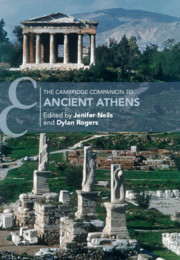Book contents
- The Cambridge Companion to Ancient Athens
- Cambridge Companions to the Ancient World
- The Cambridge Companion to Ancient Athens
- Copyright page
- Contents
- Contributors
- Abbreviations
- Athens: An Introduction
- 1 #Leagros: An Athenian Life
- Part I The Urban Fabric
- Part II Inhabitants
- Part III Business/Commerce
- 15 Labor and Employment
- 16 Piraeus: Harbors, Navy, and Shipping
- 17 The Archaeology of Markets and Trade
- 18 Coinage and Its Economic Implications
- 19 The Ceramic Industry
- 20 Sculpture and Its Role in the City
- Part IV Culture and Sport
- Part V Politics
- Reception
- Index
- References
19 - The Ceramic Industry
from Part III - Business/Commerce
Published online by Cambridge University Press: 10 March 2021
- The Cambridge Companion to Ancient Athens
- Cambridge Companions to the Ancient World
- The Cambridge Companion to Ancient Athens
- Copyright page
- Contents
- Contributors
- Abbreviations
- Athens: An Introduction
- 1 #Leagros: An Athenian Life
- Part I The Urban Fabric
- Part II Inhabitants
- Part III Business/Commerce
- 15 Labor and Employment
- 16 Piraeus: Harbors, Navy, and Shipping
- 17 The Archaeology of Markets and Trade
- 18 Coinage and Its Economic Implications
- 19 The Ceramic Industry
- 20 Sculpture and Its Role in the City
- Part IV Culture and Sport
- Part V Politics
- Reception
- Index
- References
Summary
The ceramic industry supplied Athenians with a wide variety of products, from fine tableware, utilitarian pottery, lamps, and figurines to water pipes and roof tiles. This chapter reviews the stages of production, from gathering and working the clay through forming and firing the final product and its sale, at home and abroad.
Keywords
- Type
- Chapter
- Information
- The Cambridge Companion to Ancient Athens , pp. 269 - 281Publisher: Cambridge University PressPrint publication year: 2021
References
Further Reading
Boardman 2001 presents an authoritative if opinionated account of the history, styles, iconography, functions, economics, and techniques of fine Greek pottery (mostly figured). For a diametrically opposed view of the enterprise, see Vickers and Gill 1994. Publications of the Agora excavations offer a cross-section of humbler products: lamps and black-gloss, household, and cooking pottery (Agora vols. 4, 8, 12, 22, 29, and 33) of the seventh to the first century. On a specific Late Archaic assemblage of pottery from the Agora, see Lynch 2011. For figurines, see Thompson 1987 and Uhlenbrock 1990. Winter 1993 provides an introduction to Greek roofing systems down to the end of the Archaic period. Clay preparation, the construction of fine pottery, and the three-stage firing process are explained in Noble 1988 and Schreiber 1999, the latter written from the perspective of an experienced potter. For recent discussions of the size and structure of the Athenian figured pottery industry, see Stissi 2012 and Sapirstein 2013. Peacock 1982, though focused on Roman pottery, provides a model for stages of industrial development that is also applicable to the Athenian industry; Hasaki 2020 examines ancient pottery production, especially at Corinth. For ceramic kilns in ancient Greece see https://atlasgreekkilns.arizona.edu/. Most of the evidence for prices comes from graffiti (Johnston 1979) and the lists of confiscated items in the Attic Stelai (Amyx 1958). For a sample of the heated debate over the value of pottery and the nature and significance of the trade in figured ware, see: Boardman 1988, Vickers and Gill 1994, and Osborne 1996.



